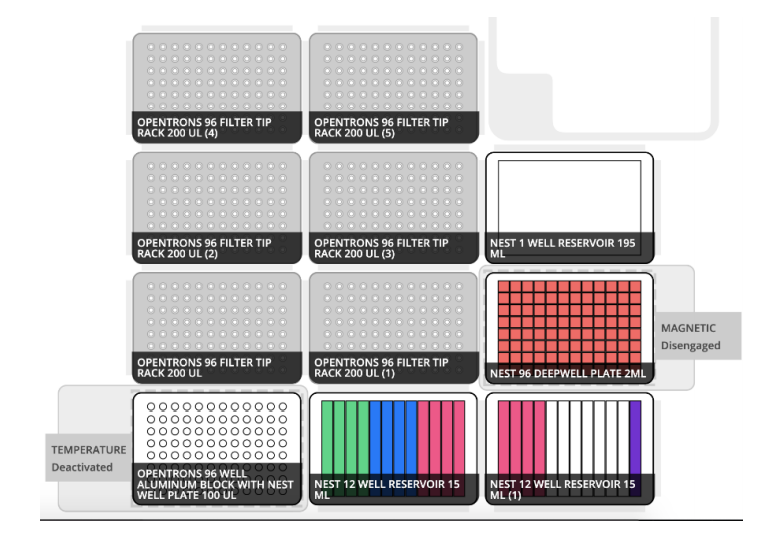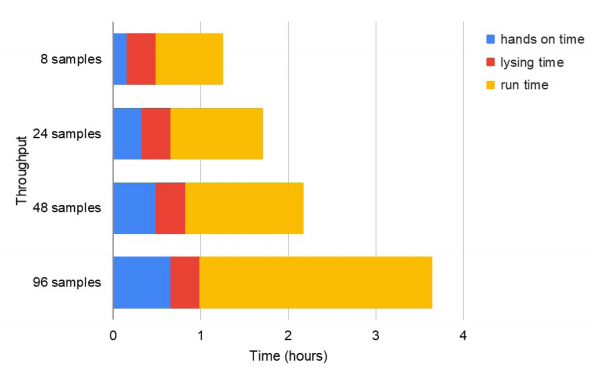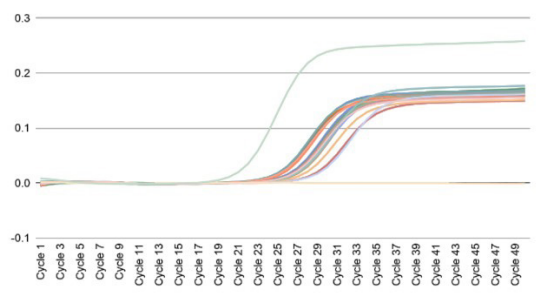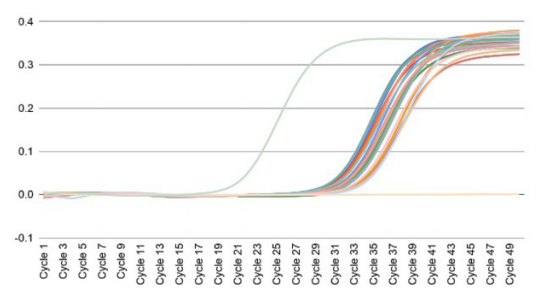Robust and High-Throughput SARS-CoV-2 Viral RNA Detection, Research, and Sequencing Using RNAdvance Viral and the OT-2 Platform
1 Jethary Rader; 1 Kinnari Watson, Ph.D.; 1 Morayo Adebi, Ph.D.; 2Han Wei, Ph.D.
Affiliation: 1 Opentrons Labworks, New York, NY; 2Beckman Coulter Life Sciences, Indianapolis, IN
Introduction
The current global pandemic (SARS-CoV-2) has highlighted a critical need to support high-throughput RNA detection and genetic sequencing for clinical research purposes. The ability to extract and purify sequencing grade viral RNA from samples has been hindered by non-optimized protocols. Here we demonstrate an automated SARS-CoV-2 RNA extraction workflow using a Beckman Coulter Life Sciences RNAdvance Viral kit (C63510) on an Opentrons OT-2 robot; an open-source robotic liquid handling platform. We present analytical data showing the SARS-CoV-2 limit of detection (LoD) quantified by qRT-PCR and sequence alignment data that establishes proof of principle for automated sequencing sample and library preparation for possible genetic identification of mutated strains.
Overview of the RNAdvance Viral kit and OT-2 platform
The RNAdvance Viral kit efficiently extracts viral RNA from samples by utilizing SPRI paramagnetic bead-based technology. We employed this reagent chemistry on the automated Opentrons platform to extract viral RNA from synthetic nasal matrix (110 mM NaCl, 1% w/v mucin from porcine stomach type II (Sigma M2378-100G) and 10 μg/mL w/v human genomic DNA (Coriell NA12878) at 90% v/v of TE/SNM) samples spiked with different concentrations of heat-inactivated SARS-CoV-2 (ATCC® VR-1986HK™). Each concentration included 20 test samples, 2 positive controls, and 2 negative controls.
Workflow Throughput
The demonstrated OT-2 deck layout for an automated RNAdvance Viral extraction workflow is shown in Figure 1. The workflow started from the addition of Bind (BBB) to the sample lysate and only requires 10 tips/sample with flexibility to run batch sizes of 8 up to 96 samples. Reported workflow durations include hands-on time, sample lysing time, and run-time for the samples after optimization (Figure 2). The 96 samples workflow takes a total of 3.5 hours using the RNAdvance Viral kit and OT-2 platform and can be accessed here: https://protocols.opentrons.com/protocol/bc-rnadvance-viral. Users have the flexibility to alter method variables to achieve the desired results for batch size, sample input, and elution volume.
Figure 1. Opentrons OT-2 deck layout equipped with modules, labware, and RNAdvance Viral Reagents. With 10 tips/sample, this workflow is fully automated on the OT-2 starting with the addition of Bind (BBB). Deck layout includes up to 10 tip racks, 1 x NEST 1 well reservoir, 2 x NEST 12 well reservoirs, 1 x 96 well aluminum block, 1 x NEST 0.1mL PCR plate and 1 x NEST 2mL Deep well plate for labware. Modules include a GEN 2 Magnetic Module and a GEN 2 Temperature module with a GEN 2 P300 Multichannel pipette. All NEST consumables and modules are supplied by Opentrons.
A
| Batch size | Run time | Lysing time | Hands-on time | Total workflow time |
| 8 samples | 45 minutes | 20 minutes | 10 minutes | 1 hour, 15 minutes |
| 24 samples | 1 hour, 2 minutes | 20 minutes | 20 minutes | 1 hour, 40 minutes |
| 48 samples | 1 hour, 20 minutes | 20 minutes | 30 minutes | 2 hour, 10 minutes |
| 96 samples | 2 hours, 38 minutes | 20 minutes | 40 minutes | 3 hour, 38 minutes |
B
Figure 2. Throughput Utilizing the RNAdvance Viral kit on the OT-2 platform. Workflow completion times include 3 sections: hands on time, lysing time, and run time. Hands on time includes preparing the samples and the OT-2. Run time refers to the time it takes for the OT-2 to complete the protocol from start to finish. A) The run time ranges from 45 minutes for 8 samples to 2 hours and 38 minutes for 96 samples. B) Graphical representation of the timing.
RNAdvance Viral Kit Limit of Detection
The limit of detection (LoD) was used to determine the automated RNAdvance Viral extraction efficiency on the OT-2 platform and was considered the lowest concentration of viral copy number that can be detected in ≥95% of repeat measurements. Samples were probed with the 2019–nCoV CDC N1 and RP Primers and Probes (2019-nCoV CDC EUA kit, Integrated DNA Technologies (IDT)), the master mix and enzyme (Luna® Universal Probe One-Step RT-qPCR Kit, New England BioLabs) on the PCRmax ECO48 Real-Time PCR System. Viral RNA (copies/µL) were detected in SARS-CoV-2 samples (n=20), positive controls (n=2) but not negative controls (n=2). As summarized in Table 1, all the contrived positive samples across the analytical range were determined to be positive, with 1 copy/µL being the lowest concentration of viral RNA detected by PCR. The PCR parameters were as follows.
| Target level (copies/uL) | No. of Positives / Total No of replicates | Mean Ct |
| 50 | 20/20 | 32 |
| 10 | 20/20 | 34 |
| 5 | 20/20 | 35 |
| 1 | 20/20 | 37 |
Table 1. Viral sensitivity depicted through the SARS-CoV-2 target N1 limit of detection using the OT-2 platform and RNAdvance Viral kit. 1 copy/µL was the lowest concentration to detect ≥95% of the samples and is defined as the limit of detection (LoD).
To investigate the automation performance of RNAdvance Viral on the OT-2, we spiked in synthetic nasal matrix with 850 copies/µL concentrations of heat-inactivated SARS-CoV-2 and extracted RNA. The specifications, including mean Ct value, standard deviation, CV (%), and detection rate, were determined for N1 and RP (Figure 3A). Amplification curves for the N1 target were quantitated in experimental samples (n=20), positive (n=2) and negative (n=2) controls (Figure 3B) versus quantitation of RP targets in samples, including controls (Figure 3C).
A
| N1 | RP | |
| Mean (Ct) | 26 | 33 |
| Standard deviation | 1 | 1 |
| CV (%) | 4 | 3 |
| Detection Rate | 100% | 100% |
B
C
Figure 3. Reliable performance of the OT-2 using RNAdvance Viral reagents depicted through various specs and amplification curves. A) Mean Ct, standard deviation, CV (%) and overall detection rate of N1 and the internal control, RP. Both targets detected 100% of the samples. B) Amplification curves of all samples amplified with N1 target including a positive and negative control. C) Amplification curves for all samples amplified with RP target including a positive and negative control.
DNA Sequencing and Data Analysis
To further understand the sequence performance, the N1 amplified samples were generated using the Swift 2S Turbo DNA library prep kit and Swift Unique Dual Indexing Primer Plate. The comprehensive data and sequence alignment from the 850 copies/µL samples can be found in Figure 4. We observed a sample mean coverage of 455x and mean reads aligned to reference genome, SARS-CoV-2 isolate Wuhan-Hu-1 (NC_045512.2) at 91%. The read length matches the N1 amplified region, which is about 72 bp. The expected insert size according to the Swift 2s Turbo DNA Library Prep manufacturer is ~200bp.
Sequencing was performed using the Illumina MiSeq and screening data was uploaded to Illumina BaseSpace. Coverage was determined using Bowtie2 in Galaxy and visualized using Integrative Genome Viewer (IGV). NC_045512.2, SAR2-COV-2, isolated Wuhan-Hu-1, was the NCBI reference genome used for sequencing. Alignment, read length, insert size, and GC content was identified using QualiMap-BAMQC in Galaxy.
A
| Comprehensive data QC | |
| Samples | n=20 |
| Total Reads | 1,02,78,300 |
| % Pass-filter | 96% |
| % Q30 | 92% |
| Mean Reads Aligned to Reference Genome | 91% |
| Mean Read Length | 72 |
| Mean Insert Size | 189 |
| Mean GC Content | 51% |
| Mean Coverage | 455-x |
B
Figure 4. Sequencing comprehensive data and coverage visualization from samples extracted on the OT-2. A) Comprehensive data QC table depicting several data points including mean coverage at 455-x and mean reads aligned to reference genome, SARS-CoV-2 isolate Wuhan-Hu-1 (NC_045512.2) at 91%. The expected insert size according to the Swift 2s Turbo DNA Library Prep manufacturer is ~200bp. B) Percent aligned to reference genome for each sample.
Conclusions
We present here a robust, highly affordable automated extraction solution utilizing the Beckman Coulter Life Sciences RNAdvance Viral kit and Opentrons OT-2. The workflow was optimized for viral RNA PCR detection with analytical performance measured at LoD of 1 copy/µL for SARS-CoV-2. We also show the protocol is suitable for NGS with high mean sample coverage at 455x and mean reads aligned to SARSCoV-2 reference genome at 91%. This evaluation enables the use of RNAdvance Viral reagents and the Opentrons OT-2 in a streamlined workflow to obtain sequenceable input samples for clinical researchers studying the SARS-CoV-2 virus.
For research use, not intended for diagnostic purposes.
Beckman Coulter makes no warranties of any kind whatsoever express or implied, with respect to these protocols, including but not limited to warranties of fitness for a particular purpose or merchantability or that the protocol is non-infringing.
All warranties are expressly disclaimed. Your use of the method is solely at your own risk, without recourse to Beckman Coulter. Not intended or validated for use in the diagnosis of disease or other conditions. These protocols are for demonstration only and are not validated by Beckman Coulter.
Learn More About Viral RNA Extraction
Helpful Links:
Extraction Kits:
RNAdvance Viral
RNAdvance Viral XP
Performance Data
Genomic Automated Workstations:
PCR Purification
RNA/DNA Extraction







